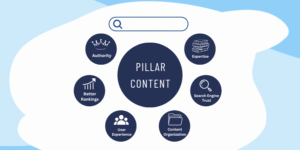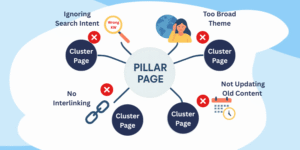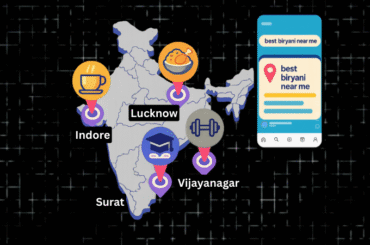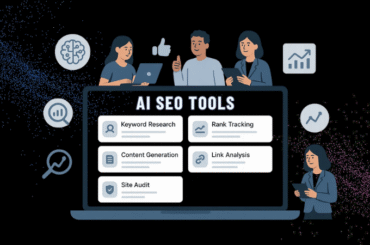Ever felt like, even after writing blog after blog, month after month, why is nothing working to improve our site rankings?
Well, here’s the bare truth – random content doesn’t hit the mark anymore.
And it’s not me saying this. The latest Google rollout update verifies this statement. That is because Google wants proof. Proof of authority. Proof that your website is the go-to resource on a specific subject.
So what do you do to build that authority, that trust? Topic Cluster SEO – the fastest way to get to the top of Google rankings and build reputation, confidence, and authority in your domain.
When your website hits the top results, Google rewards, prospective clients notice, rankings go up, and business booms. Simple?
Let’s simplify this further in this blog on how exactly we can build our agency’s own topic cluster framework – a repeatable system to earn consistent results and rankings, month after month.

But First, Why Does Topic Cluster SEO Matter?
To answer this question, let’s go back to the core of how Google actually operates today.
Google no longer rewards random keywords sprinkled across your blog content. Nah!
It rewards subject/topical authority.
And that is precisely what you need to build on—authority over your subject. Make your clients and readers know that you’re the boss of your domain and the go-to resource on the topic at hand.
When you succeed at convincing the relevant parties, search engines start to take notice. They start trusting your website.
The result? Your rankings on search engines bump up!
And all of this is made possible by topic cluster SEO. Here’s how:
- It helps bring about a strategic shift from keyword-rich content to authoritative content.
- It helps you organize content better, making it easier for both users and Google to follow.
- It presents your agency as the expert because you’re actually building expertise.
Takeaway: When you tire yourself out with keyword-rich blogs that don’t move the needle on the rankings, Topic Cluster SEO comes to your rescue.
Why Do Agencies Need Their Own Framework?
The answer is simple. Your clients aren’t paying you to copy-paste content from a template.
They’re paying you to get them results faster. Results that actually matter, and which they could not manage to obtain alone.
This is why you need your own framework, your very own Topic Cluster SEO.
It is only then that you are able to:
- Secure a definite ROI with a clearly defined process
- Regularly control the workflow and repeat the same across different clients and projects, and
- Regain control of SEO, switching it from a guessing game to a predictable, manageable engine
Takeaway: You don’t have to reinvent the wheel. You only need to customize the wheel to fit your client’s needs well.
A topic Cluster SEO helps you do just that. Let’s see how in the next section.
So, How Does Topic Cluster SEO Work?
As mentioned earlier, Topic Cluster SEO works at organizing your content around a specific theme. It essentially structures your content into:
- Pillar Pages: These are typically long and comprehensive guides that cover a broad topic in elaborate detail.
- Cluster Pages: These blogs are relatively shorter in length; however, they have a clear focus on breaking down the different subtopics of the broader topic in question.
- Internal Links: They form a crucial part of the Topic Cluster SEO system, strategically interlinking pillar and cluster pages to inform Google (and other search engines) that these pages are connected, despite being independent of each other.
Let’s break this down with the help of an example:
- Pillar: A Complete Guide to Studying in Australia in 2025-26
- Clusters: Top Universities in Australia, Eligibility Criteria to Study in Australia in 2025, Cost of Studying in Australia 2025, Step-by-Step Process to Apply for an Australian Study Visa
As you can see, the cluster pages are all related to the main pillar page, which is a broader guide to studying in Australia.
As such, they can all be linked back to the pillar page as well, reinforcing the client’s authority on the subject—studying in Australia—and attracting students aspiring to study in the country.
You, too, can create your very own Topic Cluster SEO. It’s simple, really! Let’s check out the structure below:
Step 1: Pick a Central Theme
The very first step is to select the right theme for your Pillar pages. The key here is not to begin with keywords, but with clearly defined client goals.
Understanding and following through on your client’s objectives will help you choose the right theme for your Pillars, allowing the remaining structure to fall into place naturally.
Here are a few questions you can ask before picking a central theme for the Pillar page:
- What is your target audience consistently looking for?
- What products/services do your clients want to focus more on and, most importantly, how can you help here?
- Where are your clients’ competitors already ruling (in which segment of the market), and what are the gap areas, if any?
Once you have clear answers to the above, start translating them into broader topics to cover, creating a framework.
Example: Your client is an online platform providing online education to students worldwide. Popular Pillar pages can be around the following topics:
- Online MBA in India: The Ultimate Guide
- How Effective are Online Degrees?
- Future of Online Learning in India
As you can see, these are the hub pages, which pave the way for further detailed Cluster pages, thereby completing your Topic Cluster SEO framework.
Step 2: Decide the Cluster Pages
Once you have your Pillars decided, it’s time to break them into smaller, meaningful Clusters, which can be pieced together flawlessly to provide comprehensive information to your client’s target market, in turn, boosting leads and potential conversions.
Here’s how you do it.
Imagine your Cluster pages are the “supporting pillars” to your main Pillar pages. You can start building those supporting pillars by:
- Writing comparison pages that help provide readers with a clearer idea of both the covered topics, with the complete set of pros and cons for each.
- Converting popular FAQs to full-fledged blogs (because those are common, popular questions that your readers are asking and want answers to)
- Writing how-to guides that offer practical insights into popular queries that your readers may have.
Here are some examples of Cluster pages, based on the same example we shared above for a client providing online education to students:
- Pillar: Online MBA in India: The Ultimate Guide
- Clusters: Top Specializations in an Online MBA, Online MBA vs. Distance MBA: Key Differences Explained, How to Choose the Right Online MBA Specialization for your Goals
Did you see how each of the above Cluster pages links back to the main Pillar? That’s your Topic Cluster SEO at work!
Step 3: Create a Page-Linking Strategy
This is one of the most crucial stages in creating your agency’s own framework. Just publishing Pillar and Cluster pages isn’t enough.
You must also link them to each other to gain traction and inform Google of the hierarchy you have created within your framework (Pillar >> Clusters).
How to ensure the right interlinking:
- Always link Cluster pages to the relevant Pillar page.
- Also, add contextual interlinks between different Cluster pages, as relevant.
- While interlinking, use an anchor text rich in keywords; however, make sure keywords are used naturally in the text.
Takeaway: Interlinking Clusters with Pillars is like drawing a mind map; everything ties back to the central theme.
Helpful Tools for Building a Topic Cluster SEO
Creating a Topic Cluster SEO may sound overwhelming at first. However, the best part is that you don’t have to do it all manually.
Yes, you read that right. A host of online tools is readily available to help you through your process. Listed below are some of the most popular ones:
- SEMRush/Ahrefs: Helpful in conducting a keyword and competitor analysis before picking the theme for Pillar pages
- Clearscope/SurferSEO: Helps in optimizing the content for Pillar and Cluster pages, once they have been created.
- Screaming Frog: A helpful tool commonly used by expert SEO agencies to audit internal links.
Remember: Tools cannot replace strategy. You do need a human mind for that. However, they can help expedite the execution of that strategy, allowing you to show your customers faster results.

Common Mistakes to Avoid in Topic Cluster SEO
It’s only human to make mistakes. Most agencies that work with the Topic Cluster SEO technique often fall into the following errors. Here’s a list to help you avoid making the same ones:
- Don’t ignore search intent: When creating your own framework, ensure that the Pillar pages you choose align with the actual search being conducted by the end user (your target audience).
Creating pages on topics that people are actually searching for goes a long way in ensuring success.
Example: Don’t write and publish a blog on the topic “What is an MBA”. You’ll miss the mark. The person searching for an MBA program online is likely already familiar with what an MBA is. Instead, cover content on “Top 10 online MBA Programs in India” to match the exact search intent.
- Avoid picking a too broad theme for the Pillar page: Your Pillar needs to have a broad theme, yes, but you possibly can’t provide information on a topic that is too broad. Say, travel, for instance.
It is too broad a theme to pick for a Pillar page. The competition is also going to be highly tough, from Lonely Planet to Wikipedia.
Instead, narrow down your theme to what people are actually searching for.
Example: Your Pillar page can be on something like “A Complete Travel Guide to Australia for Budget-Friendly Students.”
- Don’t ignore updating old content: It should be a regular exercise that you undertake. Content is bound to become outdated over time, especially in light of changing events around us and, most importantly, Google’s content rollout updates from time to time.
Staying current and fine-tuning your previously written content to match Google’s regular updates is the way to go here.
Moreover, regularly updating content helps you demonstrate expertise and authority on the subject.
Example: You wrote a blog in 2020 on “Top 10 Study-Abroad Destinations in 2021”. It may have gained enormous traction and even ranked among the top 3 search results on Google.
But the same blog may lose its relevance (and hence authority) in 2025. The statistics become dated, and your competitors may have developed improved versions of the same topic as well.
- Avoid publishing content without interlinks: It is one of the biggest mistakes that you can make. Making your written content live on the website without inserting the relevant links to all Cluster and Pillar pages kills the core idea of creating a Topic Cluster SEO in the first place!
In short, it means an entire waste of time and effort in creating the various Pillar and Cluster pages, only to forget to link them at the end.
How to avoid this: At the start of the process, create a linking checklist. Before publishing the content, ensure that the Cluster pages link to the main Pillar page, and at least 1-2 relevant Clusters interlink to each other.
Another helpful approach is to add links during the drafting stage, rather than waiting until after the content has been published.
Lead the Race in Topical Authority Building with Straction
Topic Cluster SEO isn’t just a short-term hack to rank higher on search engines.
It is a long-term, well-thought-out strategy to demonstrate to Google (and your audience) that you hold authority over your content.
That confidence doesn’t always come easy, and definitely not at first.
It comes with a strategically built Topic Cluster SEO framework of your own, which lets Google and your potential customers build trust in your brand.
This is where you need the help of experts who know precisely how to build a repeatable framework and scale it across clients for faster results and higher rankings.
And this is precisely what we at Straction Consulting have been doing year after year with multiple top clients.
We help map your Pillars, create your Clusters, link them right, and add your unique touch to the content so that it ranks faster on search engines!
The sooner you start building a Topic Cluster SEO framework, the faster you will begin to build authority and trust, not just in the minds of your audience, but also with the main guy, “Google.”
Interested in getting started? Get in touch with our experts at Straction Consulting for a quick overview of how we can help build content authority in your market for a long time to come.
Over to you!






